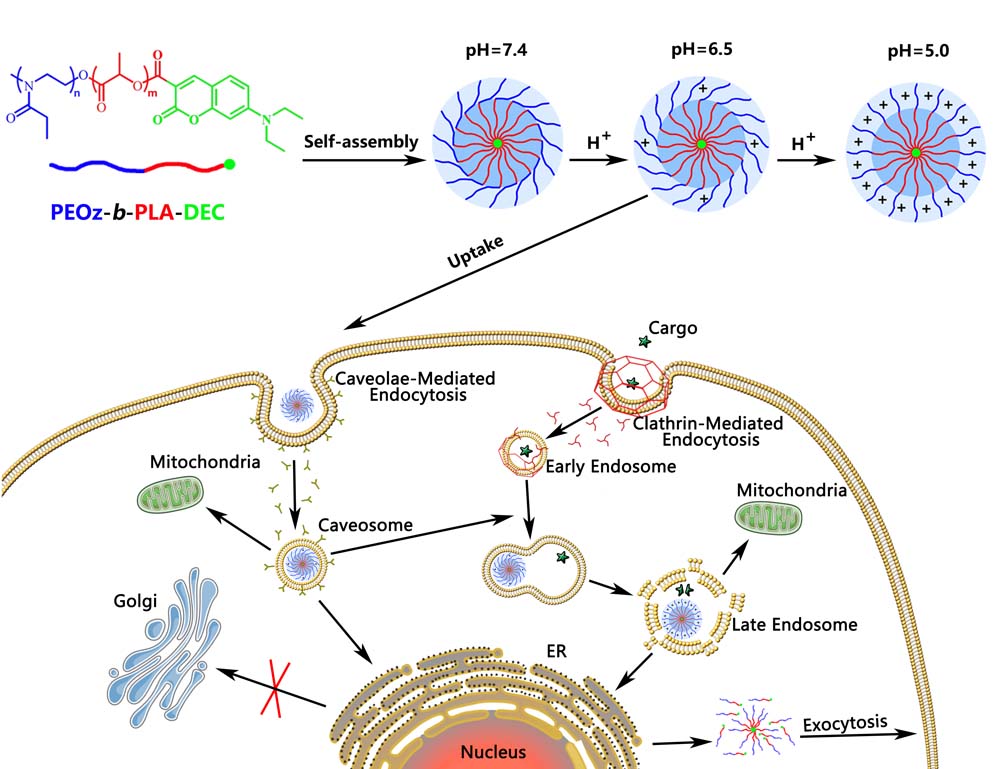Mechanisms of pH-sensitivity and cellular internalization of PEOz-b-PLA micelles with varied hydrophilic/hydrophobic ratios and intracellular trafficking routes and fate of the copolymer.
Dishi Wang, Yanxia Zhou, Xinru Li, Xiaoyou Qu, Yunqiang Deng, Ziqi Wang, Chuyu He, Yang Zou, Yiguang Jin, Yan Liu*. ACS Applied Materials and Interfaces , 2017,9:6916-6930.
Abstract:pH-responsive polymeric micelles have shown promise for the targeted and intracellular delivery of antitumor agents. The present study aimed to elucidate the possible mechanisms of pH-sensitivity and cellular internalization of PEOz- b -PLA micelles in detail, further unravel the effect of hydrophilic/hydrophobic ratio of the micelles on their cellular internalization, and examine the intracellular trafficking routes and fate of PEOz- b -PLA after internalization of the micelles. The results of variations in the size and Zeta potential of PEOz- b -PLA micelles and cross-sectional area of PEOz- b -PLA molecules with pH values suggested that electrostatic repulsion between PEOz chains resulting from ionization of the tertiary amide groups along PEOz chain at pH than lowerits p K a was responsible for pH-sensitivity of PEOz- b -PLA micelles. Furthermore, the studies on internalization of PEOz- b -PLA micelles by MCF-7 cells revealed that the uptake of PEOz- b -PLA micelles was strongly influenced by their structural features, and showed that PEOz- b -PLA micelles with hydrophilic/hydrophobic ratio of 1.7-2.0 exhibited optimal cellular uptake. No evident alteration in cellular uptake of PEOz- b -PLA micelles was detected by flow cytometry upon the existence of EIPA and chlorpromazine. However, the intracellular uptake of the micelles in the presence of M β CD and genistein was effectively inhibited. Hence, the internalization of such micelles by MCF-7 cells appeared to proceed mainly through caveolae/lipid raft-mediated endocytosis without being influenced bytheir hydrophilic/hydrophobic ratio. Confocal micrographs revealed that late endosomes, mitochondria and endoplasmic reticulum were all involved in the intracellular trafficking of PEOz- b -PLA copolymers following their internalization via endocytosis, and then part of them was excreted from tumor cells to extracellular medium. These findings provided valuable information for developing desired PEOz- b -PLA micelles to improve their therapeutic efficacy and reducing the potential safety risks associated with their intracellular accumulation.
Keywords:PEOz- b -PLA; hydrophilic/hydrophobic ratio; pH-responsive polymeric micelles; pH-sensitivity mechanism; intracellular trafficking; endocytosis mechanism
Graphical Abstract:

